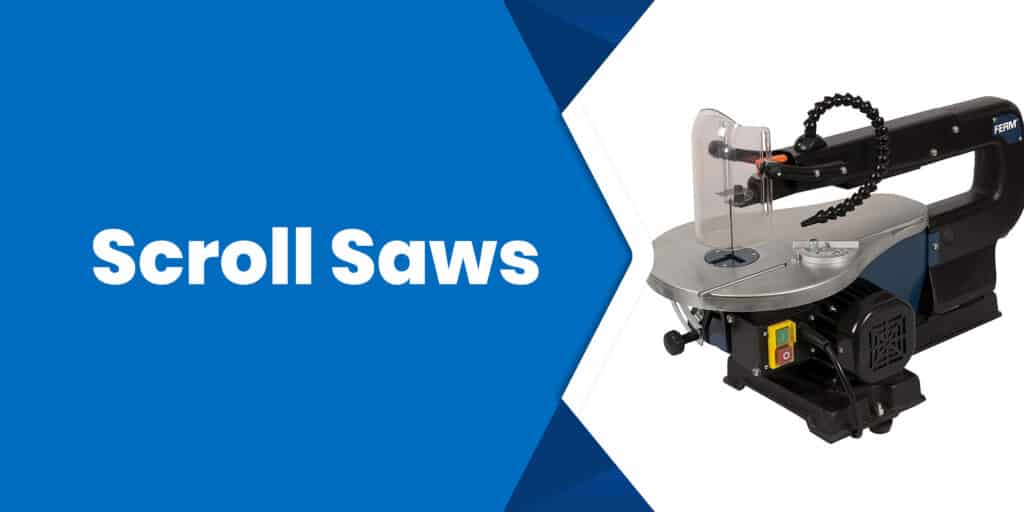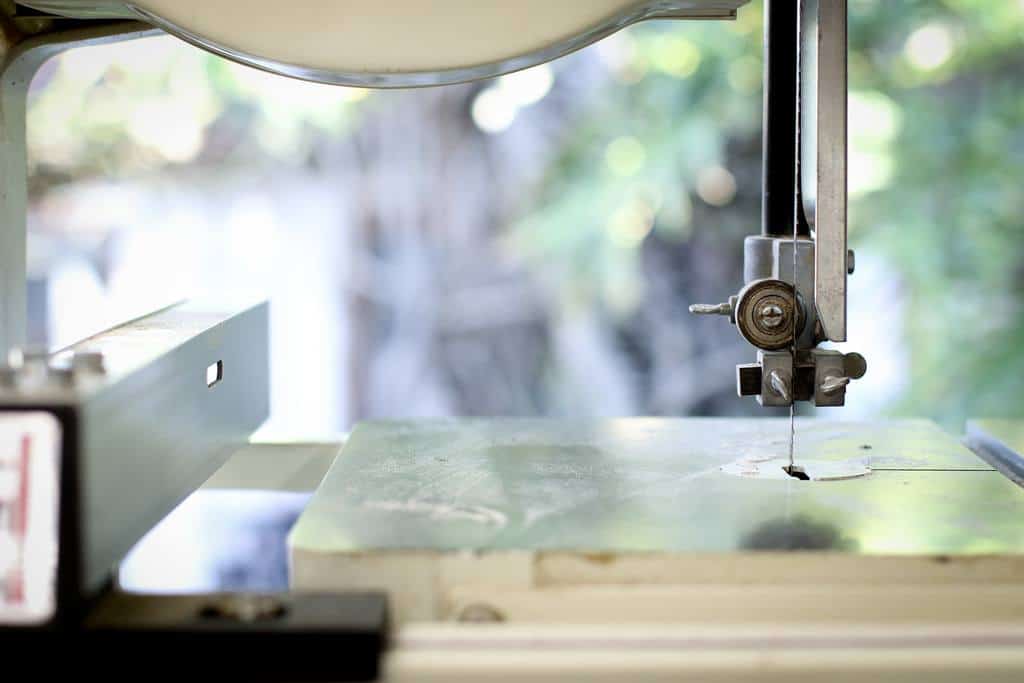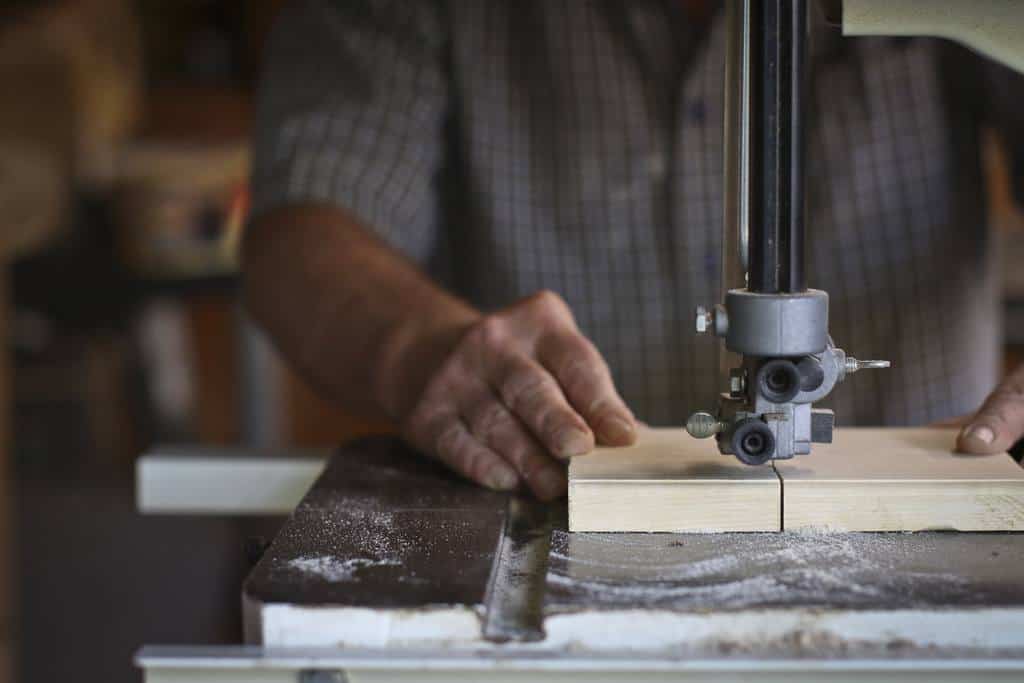
As an Amazon Associate we earn from qualifying purchases.
Similar in many ways, scroll saws and band saws have a lot in common. And yet, in practice, each saw is used for very different purposes. For your woodworking and DIY projects, it is vital you understand the “scroll saw vs. band saw” debate, and which saw is best for your needs.
Although a scroll saw and a band saw are designed to cut curves in wood, each tool has a slightly different purpose. And each has different strengths and weaknesses. Before you can decide which you need, you should know what you want to achieve.
Are you planning on using your saw to cut intricate detail into wooden panels or to create ornaments? Perhaps you are thinking of a slightly bigger project like creating arched moldings or beautifully crafted furniture? Depending on which direction your woodworking is going in, you might need a different tool.

Here I will show you how to choose between these tools for what you want to do and highlight the features you need to look for to ensure you’re getting a good quality tool:
Contents
Bandsaw vs Scroll Saw
At first glance, a scroll saw and band saw are very similar.
- Both have a blade that sits in an upright fashion, perpendicular to a large platform.
- In both saws, the blade moves up and down in order to cut the material.
- You use both saws in a similar fashion – rest the material on the table and slowly push and direct it through the blade.
However, while appearing similar at first glance, both saws have very specific uses. If you want the short, down-and-dirty difference between a scroll saw and band saw, here is my quick summary:
A band saw can cut a wide array of materials and can cut very thick materials, but it can’t cut tight curves and turns. On the other hand, a scroll saw can cut very tight curves and turns but is limited in the type of materials and thickness it can cut.
That only tells a fraction of the story, though. It is important to understand the perks of each, and when to use which saw.

Scroll Saws

Scroll saws are a speciality saw with a thin blade that moves in an up and down motion perpendicular to a large flat table. A highly rated and reviewed scroll saw will allow you to intricately make cuts for a variety of woodworking projects. Check this Dewalt DW788 Saw.
Features
A scroll saw is a great tool for detail work, such as cutting tight curves on artistic projects like making clocks and puzzles or even your favorite Christmas time ornaments and decor. It is especially good at cutting tiny arcs with ease, allowing for complete precision.
Narrow Cuts
The narrow blade of the scroll saw cuts a narrow slice through the wood resulting in a thin kerf that allows for pieces to be easily slotted back together.
Although that feature doesn’t sound very useful for most projects, if you’re producing marquetry and wood inlays, the scroll saw is what you need.
Scroll saws are the perfect tool for cutting curved edges on thin materials.
Cutout Shapes
Another feature of the scroll saw that makes it popular for more craft-like projects with wood is that it can make cutout shapes in the middle of a part without cutting through rough edges.
Let’s say you’re making a clock. You can cut a large ring from a piece of plywood and then create a cutout inside it for the mechanism easily with a scroll saw.
On the other hand, using a band saw would mean you would have to cut right through the inner ring, which would not do the job at all.
Detachable Blade
Scroll saws have a relatively slow blade speed in comparison to the band saw. Scroll saws cut between 400-1,200 strokes per minute. Their slow blade speed makes them a relatively easy saw to operate.
The scroll saw also has a detachable blade at one end, which allows blade changes in seconds. This permits you to drill a hole in a piece of wood, insert the scroll saw blade through the hole, and then reattach it to the scroll saw so that you can make your cutout.
It is this feature of the saw that makes it popular with woodworkers for making highly detailed artwork such as portraits and landscapes out of wood. Most scroll saws can cut material up to an inch thick, which is all you need for the majority of craft projects.

Blade Types
You also need to determine the type of scroll saw blade you need:
Pin-end Blades
Pin-end blades don’t need a clamp, which makes tensioning it relatively easy because the blade is locked-in (if it’s still too tough for you, you can always use a tensioning knob). However, some woodworkers say they find pin-end blades to lack variety and that they are not suitable for passing through very small holes in more intricate projects.
Pin-end blades are thicker because they will not be locked into the machine properly if the metal is too thin. This can create a couple of problems.
Tight turns can cause the blades to break more easily, and the pin is too large for a lot of projects the scroll saw is required for.
Flat or Plain-end Blades
More widely available, flat blades are pinched in place by two small clamps on the scroll saw. One of the clamps is above the saw’s work table, and the other is below. The blade is passed through a slot between the two.
The majority of people using scroll saws prefer flat blades. They are now considered the standard for that reason. There’s also a much wider variety of plain-end blades available to suit a broader range of projects.
There are some scroll saw machines that allow for both pin-end and flat blades for maximum flexibility.
Purchase Considerations
Other things to consider when buying a scroll saw include:
- Size of the machine’s worktable and throat size
- Whether it has a variable or constant blade speed
- Add-ons like blowers, foot pedals, lights, etc.
- The brand (if it’s important to you)

Pros & Cons
Now that you’ve gotten a thorough overview of what the scroll saw can best tackle, here is an overview of the pros and cons of this specific saw:
Pros
- Best tool for woodworking crafts and carvings
- Precise and accurate, providing a fine cut requiring minimal sanding
- Has the capacity to cut out shapes inside materials due to its detachable blade
Cons
- Not suitable for use with materials more than one inch
- Not ideal for accurate straight cuts as the scroll saw is designed to create curves
Band Saws

Although the scroll saw is exceptionally versatile for intricate woodwork, it still has limitations, and that’s where the band saw can step in.
A highly-rated band saw is perfect for taking on bigger projects or when you need something to take on different cuts in varying thicknesses of materials. Check this JET 14″ Pro Band Saw.
Features
Unlike scroll saws, bandsaws feature a blade that cuts in the same direction. The blade’s continuous downward motion allows it to achieve very different cuts than a scroll saw, who’s reciprocating blade moves up and down.
As a result, a band saw can achieve a clean and intricate cut in comparison to scroll saws. A bandsaw’s blade speed is twice as powerful as a scroll saw.
The band saw is a lot more versatile of a saw than most give it credit for. While the jigsaw and table saw are uber-popular, the band saw slips under the radar of the general population.
Here are a few things that the band saw is perfect for.

Resawing
Perhaps where the band saw makes its name, resawing is a very difficult task to do if you don’t have a band saw – due to its resaw capacity. These long straight cuts, made across a board’s thickest part, are made easy with this saw style.
Rip Cutting
Long rip cuts can also be performed by a table saw, but if you don’t want to purchase both saws, a band saw can handle them just fine. Similar to resawing, a rip cut is easily handled by this saw.
You’ll use a bandsaw rip fence, the same as you would with other saw.
Cutting Thick Wood
Most saws top out at cutting wood a few inches thick, but the band saw can handle really thick wood. And I mean really thick, as in logs and large lumber. With the right blade, you can cut wood that is 6″ thick and larger.
Cutting Curves in Thick Wood
Yes, this deserves its own category. This is perhaps the single largest difference in the “scroll saw vs. band saw” comparison. Both can cut curves, but the band saw is the only saw that can cut curves in thicker wood.
Cutting Veneer
One thing band saws are particularly useful for is creating veneer panels that can be used for a wide range of finishes around the home. This incredibly precise type of cut is best done by the band saw, as the table saw is not accurate enough and leaves fraying.
Bandsaw Types
There are several types of band saws, each designed to achieve certain things better than others:
Benchtop
These are small and portable and are meant for woodworkers who may not have space for a bigger tool.
Although they are small, benchtop band saws are really versatile and capable of cutting big sweeping curves in either plywood or thick hardwoods with equal ease.
Stationary
Stationary band saws are bigger and more powerful than the benchtop version. They can easily outperform most other types of saws, particularly on hardwoods like oak, pecan, and hickory.
This kind of band saw also has wider blades, meaning they can produce smoother and straighter cuts. As a result, they are not as good with tight turns.

Resaw
This machine is used specifically to create thin planks of wood and also cut veneers from solid wood. This makes it ideal for instrument makers to create soundboards and backs for string instruments like violins and guitars.
Larger resaw band saws are also able to cut curves. Although when wide blades are used, these are limited to large arcs.
However, they aren’t really designed for creating curves in wood as a principal feature. So, if your project generally requires smaller blades, you’re likely to need a different type of band saw.
Pros & Cons
The band saw is perfect for resawing and cutting curves in the thick wood, but it isn’t for everything. Here are the general pros and cons of this saw:
Pros
- Ideal for thick materials
- Cuts straight lines quickly and accurately
- Capable of creating ultra-thin veneers
Cons
- Rough edge cuts which require sanding
- Not capable of cutting out shapes inside materials without cutting through the edge

Scroll Saw vs Band Saw
As with all woodworking tools, which one is best for the purpose depends on what that purpose is. So, there is no clear winner – it depends on your project and your cut.
Scroll Saw
Most woodworkers consider scroll saws to be more of a ‘specialty’ tool that’s designed for the smaller, more intricate craft projects with complex cutting patterns.
The kinds of pieces that are created using a scroll saw include jigsaw puzzles, marquetry, and wooden sculptures, or ornaments. Use a scroll saw for:
- Tight, intricate cuts with thin, fragile wood
- Cuts that require you to start from inside of the material
One advantage that a scroll saw has is that it cuts so finely that there is usually no need to sand afterward. Although, this is limited to working with smaller pieces than you can with a band saw.
Band Saw
On the other hand, band saws are great for a serious or professional woodworker looking to work with much larger designs and material surfaces.
Band saws are very versatile and can take on most standard and custom cuts. Because they can be adjusted vertically, it’s easily possible to cut much larger materials than with other saws.
Use a band saw for:
- Resawing and rip cuts
- Cutting thicker material
- Cutting curves and circles in thicker wood
There’s a greater variety of blades available for a band saw than for a scroll saw, with different widths and tooth styles to allow for varying cuts. Bandsaws also operate at a mcbh higher blade speed, twice that of a scroll saw. Perhaps the greatest advantage of a band saw over a scroll saw is that you can cut thick material quickly and accurately.
This means if your project involves cutting lots of odd angles and patterns, the band saw is probably slightly better for the job than the scroll saw.
Conclusion
Now that you know the difference between a band saw and a scroll saw, you can probably determine which suits your purposes best. Settling the “scroll saw vs band saw” debate starts with thoroughly understanding what each saw does best, and the needs of your specific project.
Selecting the right saw depends on what you want to achieve. Where the scroll saw can cut intricate patterns, the band saw can cut ultra-thin veneer panels. They both have their own unique features. It’s up to you to decide which of these features are most appropriate for the project you have in mind.
Professional woodworkers who routinely get involved in different kinds of projects are more likely to need to buy both the band and scroll saw. Most hobbyists could probably settle on one – either a scroll saw or a band saw, depending on their needs. The band saw is generally regarded as the workhorse of the workshop as it is more flexible than the scroll saw in terms of the project size – it also allows clearer cuts due to the limited side-to-side movement of your material.
Safety is always paramount when operating machinery of any kind, and for that reason, I always advise you read the manufacturer’s instructions when purchasing a new piece of equipment.
Preparing your work area and keeping your tools orderly and dust-free (thanks to a dust port included in many) is also important so that you achieve the very best results for all your woodworking jobs.

